
Mikasa (三笠) is a pre-dreadnought battleship built for the Imperial Japanese Navy (IJN) in the late 1890s, and is the only ship of her class. Named after Mount Mikasa in Nara, Japan, the ship served as the flagship of Vice Admiral Tōgō Heihachirō throughout the Russo-Japanese War of 1904–1905, including the Battle of Port Arthur on the second day of the war and the Battles of the Yellow Sea and Tsushima. Days after the end of the war, Mikasa's magazine accidentally exploded and sank the ship. She was salvaged and her repairs took over two years to complete. Afterwards, the ship served as a coast-defence ship during World War I and supported Japanese forces during the Siberian Intervention in the Russian Civil War.

The Ise-class battleships were a pair of dreadnought battleships built for the Imperial Japanese Navy (IJN) during World War I. Both ships carried supplies for the survivors of the Great Kantō earthquake in 1923. They were modernized in 1934–1937 with improvements to their armour and machinery and a rebuilt superstructure in the pagoda mast style. Afterwards they played a minor role in the Second Sino-Japanese War.

Satsuma (薩摩) was a semi-dreadnought battleship built for the Imperial Japanese Navy (IJN) in the first decade of the 20th century. Lead ship of her class, she was the first battleship built in Japan. She was named for Satsuma Province, now a part of Kagoshima prefecture. The ship saw no combat during World War I, although she led a squadron that occupied several German colonies in the Pacific Ocean in 1914. Satsuma was disarmed and sunk as a target in 1922–1924 in accordance with the terms of the Washington Naval Treaty of 1922.

Fusō (扶桑) was a central-battery ironclad built for the Imperial Japanese Navy (IJN) in the 1870s. She was built in the United Kingdom because such ships could not yet be constructed in Japan. The ship participated in the First Sino-Japanese War of 1894–95 where she was damaged during the Battle of the Yalu River in 1894 and participated in the Battle of Weihaiwei in early 1895. She collided with two Japanese ships during a storm and sank in 1897. She was refloated the following year and repaired. Fusō played a minor role in the Russo-Japanese War of 1904–1905 and was reclassified as a coast defense ship after the war. She was struck from the Navy List in 1908 and sold for scrap the following year.
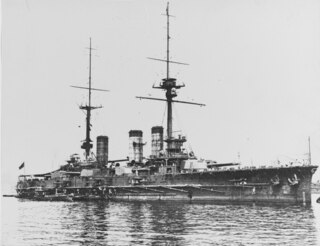
Aki (安芸) was one of two Satsuma-class semi-dreadnought battleship built for the Imperial Japanese Navy (IJN) during the first decade of the 20th century. She was the second battleship built domestically in Japan and the first to use steam turbines for propulsion. The ship was named for Aki Province, now a part of Hiroshima Prefecture. The ship saw no combat during World War I. Aki was disarmed in 1922 and sunk as a target in 1924 in accordance with the terms of the Washington Naval Treaty of 1922.
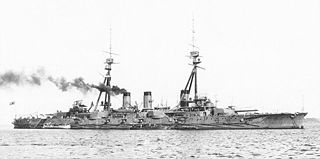
Settsu (摂津) was the second and last of the Kawachi-class dreadnought battleships built for the Imperial Japanese Navy (IJN) in the first decade of the 20th century. Following the Japanese ship-naming conventions, Settsu was named after Settsu Province, now a part of Osaka prefecture. During World War I she bombarded German fortifications at Qingdao during the siege of Qingdao in 1914, but saw no other combat. She was placed in reserve in 1919 and was disarmed in 1922 in accordance with the terms of the Washington Naval Treaty.

Kawachi (河内) was the lead ship of her class of two Kawachi-class dreadnought battleships built for the Imperial Japanese Navy (IJN) in the 1910s. Completed in 1912, she often served as a flagship. Her only combat action during World War I was when she bombarded German fortifications in China during the Battle of Tsingtao in 1914. She sank in 1918 after an explosion in her ammunition magazine with the loss of over 600 officers and crewmen.

Kashima was the second ship of the two Katori-class pre-dreadnought battleships built for the Imperial Japanese Navy (IJN) in the first decade of the 20th century, the last to be built by British shipyards. Ordered just before the start of the Russo-Japanese War of 1904–1905, the ship was completed a year after its end. She saw no combat during World War I, although the ship was present when Japan joined the Siberian Intervention in 1918. Kashima was disarmed and scrapped in 1923–1924 in accordance with the terms of the Washington Naval Treaty of 1922.

Pobeda was the last of the three Peresvet-class pre-dreadnought battleships built for the Imperial Russian Navy at the end of the nineteenth century. The ship was assigned to the Pacific Squadron upon completion and based at Port Arthur from 1903. During the Russo-Japanese War of 1904–1905, she participated in the battles of Port Arthur and the Yellow Sea. Having escaped serious damage in these engagements, Pobeda was sunk by gunfire during the siege of Port Arthur, and then salvaged by the Japanese and placed into service under the name Suwo (周防).

Asahi was a pre-dreadnought battleship built for the Imperial Japanese Navy (IJN) in the late 1890s. As Japan lacked the industrial capacity to build such warships itself, the ship was designed and built in the United Kingdom. Shortly after her arrival in Japan, she became flagship of the Standing Fleet, the IJN's primary combat fleet. She participated in every major naval battle of the Russo-Japanese War of 1904–1905 and was lightly damaged during the Battle of the Yellow Sea and the Battle of Tsushima. Asahi saw no combat during World War I, although the ship participated in the Siberian Intervention in 1918.

The Peresvet class was a group of three pre-dreadnought battleships built for the Imperial Russian Navy around the end of the 19th century. Peresvet and Pobeda were transferred to the Pacific Squadron upon completion and based at Port Arthur from 1901 and 1903, respectively. All three ships were lost by the Russians in the Russo-Japanese War of 1904–05; Peresvet and Pobeda participated in the Battles of Port Arthur and the Yellow Sea and were sunk during the siege of Port Arthur. Oslyabya, the third ship, sailed to the Far East with the Second Pacific Squadron to relieve the Russian forces blockaded in Port Arthur and was sunk at the Battle of Tsushima with the loss of over half her crew.
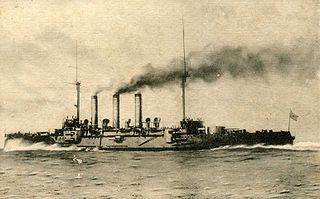
The Izumo-class cruisers were a pair of armored cruisers built for the Imperial Japanese Navy (IJN) in the late 1890s. As Japan lacked the industrial capacity to build such warships herself, the vessels were built in Britain. They were part of the "Six-Six Fleet" expansion program that began after the defeat of China during the First Sino-Japanese War of 1894–1895. The sister ships participated in three of the four main naval battles of the Russo-Japanese War of 1904–1905—the Battle of Port Arthur, the Battle off Ulsan and the Battle of Tsushima—but played a much more minor role in World War I.
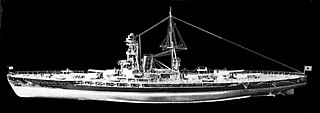
The Tosa-class battleships were two dreadnoughts ordered as part of the "Eight-Eight" fleet for the Imperial Japanese Navy (IJN) during the early 1920s. The ships were larger versions of the preceding Nagato class, and carried an additional 41-centimeter (16.1 in) twin-gun turret. The design for the class served as a basis for the Amagi-class battlecruisers.
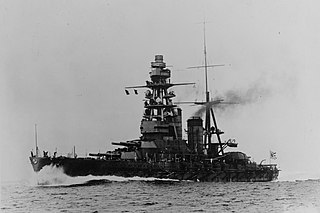
The Nagato-class battleships were a pair of dreadnought battleships built for the Imperial Japanese Navy (IJN) towards the end of World War I, although they were not completed until after the war. The last of Japan's pre-Treaty capital ships, they were the first class to carry 41 cm (16.1 in) guns, the largest afloat and the first bigger than 15 inches (381 mm). Nagato, the lead ship of the class, frequently served as a flagship. Both ships carried supplies for the survivors of the Great Kantō earthquake in 1923. They were modernized in 1933–1936 with improvements to their armor and machinery and a rebuilt superstructure in the pagoda mast style. Nagato and her sister ship Mutsu briefly participated in the Second Sino-Japanese War in 1937 and Nagato was the flagship of Admiral Isoroku Yamamoto during the attack on Pearl Harbor on 7 December 1941 that began the Pacific War.

The Satsuma class was a pair of semi-dreadnought battleships built for the Imperial Japanese Navy (IJN) in the first decade of the 20th century. They were the first battleships to be built in Japan and marked a transitional stage between the pre-dreadnought and true dreadnought designs. They saw no combat during World War I, although Satsuma led a squadron that occupied several German colonies in the Pacific Ocean in 1914. Both ships were disarmed and expended as targets in 1922–1924 in accordance with the terms of the Washington Naval Treaty of 1922.

The Fuji class was a two-ship class of pre-dreadnought battleships built for the Imperial Japanese Navy (IJN) in the mid-1890s. They were the first battleships in the IJN, and were constructed in the UK as Japan lacked the industrial facilities needed to build them. Their design was based on the battleships being built for the Royal Navy at that time.

The Katori class was a two-ship class of pre-dreadnought battleships built for the Imperial Japanese Navy (IJN) in the early 1900s. As Japan lacked the industrial capacity to build such warships itself, they were designed and built in the UK. They were the last pre-dreadnought battleships to be built for Japan at overseas shipyards, and the last to be equipped with a ram. The ships were delivered after the end of the Russo-Japanese War of 1904–1905. They saw no action during World War I, although both were present when Japan joined the Siberian Intervention in 1918. They were disarmed and scrapped in 1923–1925 in accordance with the terms of the Washington Naval Treaty of 1922.

The Tsukuba-class cruisers were a pair of large armored cruisers built for the Imperial Japanese Navy (IJN) in the first decade of the 20th century. Construction began during the Russo-Japanese War of 1904–05 and their design was influenced by the IJN's experiences during the war. The British development of the battlecruiser the year after Tsukuba was completed made her and her sister ship Ikoma obsolete, as they were slower and more weakly armed than the British, and later German, ships. Despite this, they were reclassified in 1912 as battlecruisers by the IJN.

The Ibuki class, also called the Kurama class, was a ship class of two large armoured cruisers built for the Imperial Japanese Navy after the Russo-Japanese War of 1904–1905. These ships reflected Japanese experiences during that war as they were designed to fight side-by-side with battleships and were given an armament equal to, or superior to existing Japanese battleships. The development of the battlecruiser the year before Ibuki was completed made her and her sister ship Kurama obsolete before they were completed because the foreign battlecruisers were much more heavily armed and faster.




















